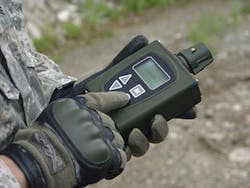Army orders pocket-size, rugged, handheld chemical warfare detectors from Smiths Detection
ABERDEEN PROVING GROUND, Md., 17 Feb. 2016. U.S. Army chemical defense experts needed additional chemical warfare detectors to help protect warfighters or emergency responders from chemical and industrial toxic agents. They found their solution from Smiths Detection in Edgewood, Md.
Officials of the Army Contracting Command, Aberdeen Proving Ground, Md., announced a $17.1 million contract modification to Smiths Detection on Tuesday for 2,092 M4A1 joint chemical agent detectors.
The contract also calls for Smiths Detection to provide 2,088 communication adapter kits; and 10 platform interface kits. Smiths Detection is a Part of Smiths Group plc.
The M4A1 JCAD is based on the Smiths Detection LCD 3.3 detect-to-warn device that protects troops or emergency responders by sampling the air for chemical warfare agents and toxic industrial chemicals.
The device is a pocket-size, rugged, handheld detector that automatically detects, identifies, and alarms to chemical warfare agents and toxic industrial chemical vapors.
Related: Block Engineering joins Leidos for active infrared spectroscopy chemical detection
The unit weighs less than two pounds, can be worn or carried by troops without obstructing their primary duties. The handheld detector automatically detects, identifies, and alarms to chemical warfare agents and toxic industrial chemical vapors.
Members of the U.S. military services can use the system on vehicles, at fixed sites, and on individuals designated to operate in chemical threat areas. The system can operate in a general chemical warfare environment, and can undergo conventional decontamination procedures.
The unit offers instant feedback of hazards and real-time detection of nerve, blister, and blood agents. It is network-ready with the common chemical, biological, radiological, and nuclear standard interface.
Procurement of the JCAD began in 2008, and procurements of the relatively new unit based on the Smiths Detection LCD 3.3 began in 2011.
On this contract modification Smiths Detection will do the work in Edgewood, Md., and should be finished by the end of September 2016. For more information contact Smiths Detection online at www.smithsdetection.com, or the Army Contracting Command at www.army.mil/acc.

